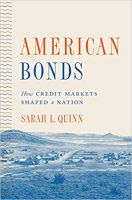American Bonds: How Credit Shaped a Nation by Sarah L. Quinn. American real estate booms leading to busts have been around as long as the United States itself, starting with the land boom and bust of 1796, which sent the great financier Robert Morris into debt prison. In the late 1880s and early 1890s it was farm mortgages and house mortgages in the Western U.S., fueled in large part by the huge appetite for high yield debt among investors on the East Coast. The story reads almost as if written in the 1920s, 1980s, or 2000s:
“As the 'farm mortgage craze' mounted, mortgage companies found that they could sell [these high-yielding] mortgage bonds faster than they could find homeowners in need of loans. Soon the mortgage companies found that the best borrowers already had mortgages.
“As with other credit bubbles, lending standards declined as more money flowed into the market. The records of the Mercantile Trust show that the company was selling bonds in Europe faster than its agents could find safe mortgages in the West. In response, the company loosened its loan approval process in an attempt to keep up. Across the market, the quality of mortgages dipped. Agents who were paid on commission found that they could earn bigger fees if they cooperated with appraisers who overvalued the land. Even the more responsible and reputable agents had a tendency to save the best mortgages for the brokerage business and to shunt their most unusual mortgages into pools that investors tended not to examine closely.
“After the 1873 crash, state examiners reviewed the pools and found that many were under collateralized. Around 1887, agents at J. B. Watkins in Colorado reported that competition from lenders was creating pressure to ease credit terms: 'The great trouble is the competition all over the state, not only in rates, but in the amounts which other companies are willing to lend and also the various privileges that they give or profess to give.' By 1888, Watkins had written off the entire state of Kansas. After it concluded that Kansas 'is about played out,' the company moved on to Texas and Louisiana. Some regulators in eastern states seem to have kept an eye on the market, but it is unclear if or how their efforts affected its trajectory. When drought and depression hit in the 1890s, the highly leveraged and overextended farm mortgage business collapsed.”
| |||
| author: Sarah L. Quinn | |||
| title: American Bonds: How Credit Shaped a Nation | |||
| publisher: Princeton University Press | |||
| date: Copyright 2019, Princeton University Press | |||
| page(s): 54 |

No comments:
Post a Comment